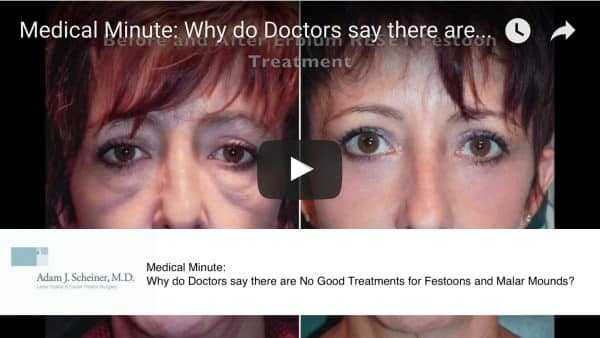Today we’re going to talk about why other doctors are not treating festoons and malar mounds, and why some doctors say there are no good treatments for festoons and malar mounds. Festoons and malar mounds are difficult conditions to treat. When discussing these conditions with their patients, many surgeons say that they can’t be treated, but that is not true.
As Laser Technology Improves So Do Treatment Options
One of the best options is using ablative laser skin resurfacing, but most physicians don’t have experience with this technique. The heyday of laser skin resurfacing was in the 90s. At that time, many practitioners were trying to use these machines. The main laser wavelength at that time was CO2, or carbon dioxide lasers. This laser had great abilities to resurface skin, but left a sizable amount of heat behind in the wound after treatment. This resulted in long healing times, extensive redness to the skin and occasional scarring. These complications were even more likely for physicians who didn’t have good initial training in lasers and dermatology.
During my fellowship I trained with a giant in the field of laser cosmetic surgery — Dr. Sterling Baker. He was the first to publish on the use of lasers for cutting skin safely, and he started the field of laser blepharoplasty. In my training with him I was exposed to many different types of lasers. Halfway through my time with him he started using a new type of laser for skin resurfacing — the Erbium wavelength. This laser was unique because it was able to put more of its energy into skin ablation and left less behind as heat after the treatment. This led to safer outcomes and fewer complications.
Sciton was the company that perfected this technology, and it developed a dual pulsed Erbium laser that was tunable. It could be either aggressive or gentle, depending upon the surgeon’s needs during the surgery. This tune-ability made it very useful for helping a wide range of patients with varying skin conditions. Unfortunately, this company was late to the product life cycle for laser skin resurfacing, and as a result of the issues with C02 laser complications in the hands of often unsophisticated physicians, laser companies were forced to develop new ways to use lasers to help patients and their skin. They moved towards non-ablative lasers and Fraxel. These lasers were unfortunately never able to deliver the same kind of results that were achieved with laser skin resurfacing. As a result, since that time laser skin resurfacing – although very successful – has fallen out of favor.
Why Many Doctors Don’t Treat Festoons
I have often wondered what would have happened had Erbium resurfacing and Sciton’s Dual Pulsed laser developed earlier in the 90s. I suspect that this safer laser would have resulted in fewer complications, and more powerful results as well. This might have meant more physicians doing ablative resurfacing procedures today. Unfortunately, today’s surgeons aren’t interested in learning about laser skin resurfacing because of their memory of past problems. Had they learned on Sciton machine years ago, they would likely love laser skin resurfacing.
I think the reason why many doctors don’t treat festoons is because they are inexperienced with using lasers to treat them. I have quietly built my skills over the past 17 years so that now I have extensive experience treating festoons and malar mounds with lasers. It would be possible for today’s surgeon to learn this, but most don’t want to bother: they are more interested in doing other procedures instead.
I’m happy that I have the ability and interest to help patients with these difficult-to-treat conditions. I really love what I do to help my patients and the impact I have on their lives afterwards.

